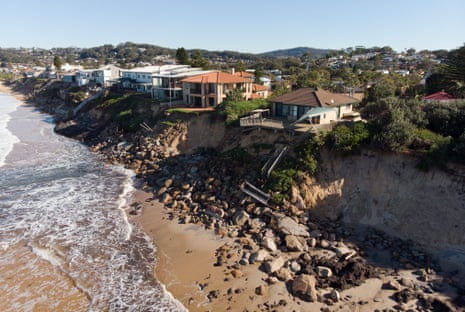A cost-benefit analysis of options for a seawall at Wamberal beach commissioned by the New South Wales government in 2017 found that none of the six engineering options considered would deliver a net public benefit and that erosion would only increase with rising sea levels.
“A seawall will provide benefits to beachfront properties by reducing the impacts of coastal processes,” the report by Marsden Jacobs found. “However, in the longer term, more properties in this area are likely to experience greater damage and loss of property values from the increased flooding of Terrigal lagoon associated with sea level rise.
“Higher sea levels will result in the increasingly frequent inundation of hundreds of properties surrounding the Terrigal lagoon, the loss of the beach, and impacts on council assets such as water, electricity, sewerage and roads,” it found.
“The key beneficiaries from construction of a seawall are the approximately 60 owners of beachfront properties at Wamberal.”
As the Central Coast of NSW braces for another lashing today, the state government is still sitting on another report by the NSW coastal council, commissioned by the local government minister, Shelley Hancock, which looks at the vexed problems of seawalls and coastal erosion in the state.
Councils up and down the coast face a dilemma: should they require their entire ratepayer base, which often includes many retirees, to support costly seawall projects that often involve ongoing requirements for beach replenishment? Or should councils be looking at adaption strategies that accept that coasts are dynamic – some areas such as Wamberal, Collaroy, Byron Bay and Port Stephens more so than others – and that the battle to protect inappropriately located development will become even more difficult due to sea level rise?
Letting properties slide into the sea is politically unpalatable and the cost of buying up the waterfront properties far more expensive than it was 50 years ago when the first problems emerged.
Former coastal council member and engineer Angus Gordon says the answer lies in changing the Local Government Act to allow councils to recoup the costs of the seawall from waterfront property owners over time, though a long-term levy on the affected properties.
Other schemes, at Collaroy, have involved subsidies from state and local government, with waterfront home owners still facing $400,000 bills to build the wall.
Yet there remains concerns about both the environmental impact of seawalls and how they will perform in the future.
The Marsden Jacobs study on Wamberal was informed by a detailed study by the then-NSW Office of Environment and Heritage, which found that the coastal processes acting on the dune that separates Terrigal lagoon from Wamberal beach – and where the most vulnerable houses are located – are complex and will get worse with sea level rise.
It found that without a wall, 82 properties in the study area are likely to be affected by coastal processes over a 20-year timeframe, and 92 properties over 50 years.
In May this year, Central Coast council commissioned Manly Hydraulic Laboratory to design a concept plan for a seawall solution. The $400,000 study is being funded by both the state government and council. Another company, Royal Haskoning DHV, looked at short-term measures.
But as the Marden Jacobs report detailed, the trade-off from protecting about 60 beachfront properties with a seawall would be the potential loss of visits due to the loss of the beach.
“This loss of visitors may create some concern in the wider Central Coast local government area, especially as 32% of the beachfront properties that would potentially be protected by a seawall (at the expense of the beach) are only occupied occasionally,” Mardsen Jacobs said.
The report considered a range of structural engineering approaches to protect beachfront properties and other infrastructure at Wamberal beach and the surrounding lagoon properties from the effects of coastal processes.
It found that none of the engineering options considered provided a net public benefit for the local community. This is because all of the seawall options would result in the loss of beach areas, and without sand replenishment the beach would quickly disappear, with significant costs to the local tourism industry.
Marsden Jacobs said it was not clear which seawall option would lead to the fastest loss of the beach but all would result in an unusable beach by 2064, without a major sand replenishment program
“The cost of sand replenishment is very high and outweighs the benefits of retaining a beach in front of a seawall,” it said. “Only a Planned Retreat option (Option 8) -retreat by managing the duration, type and intensity of future development within the coastal hazard area – provided greater benefits than a continuation of the current approach.”
The beach at Wamberal was vulnerable to erosion long before the first homes were built. Terrigal lagoon sits directly behind Wamberal beach and currently drains into the sea just to the south of the slipping houses, but locals says the lagoon used to drain to the beach at a different spot, suggesting active coastal processes.
Two storms in the 1970s – in May 74 and June 78 – saw several houses on the strip claimed by the sea. Boulders rubbish, car bodies and the remains of houses were dumped as a makeshift wall and the sand eventually returned.
At that stage the council could have bought back properties. Instead it continued to approve development, requiring new homes to have deep piles into the sand.
Comment has been sought from Central Coast council.
